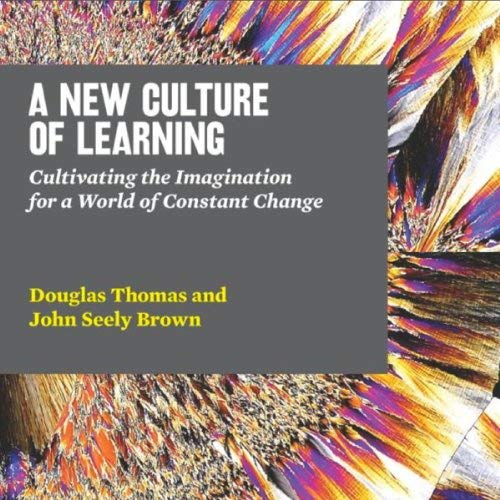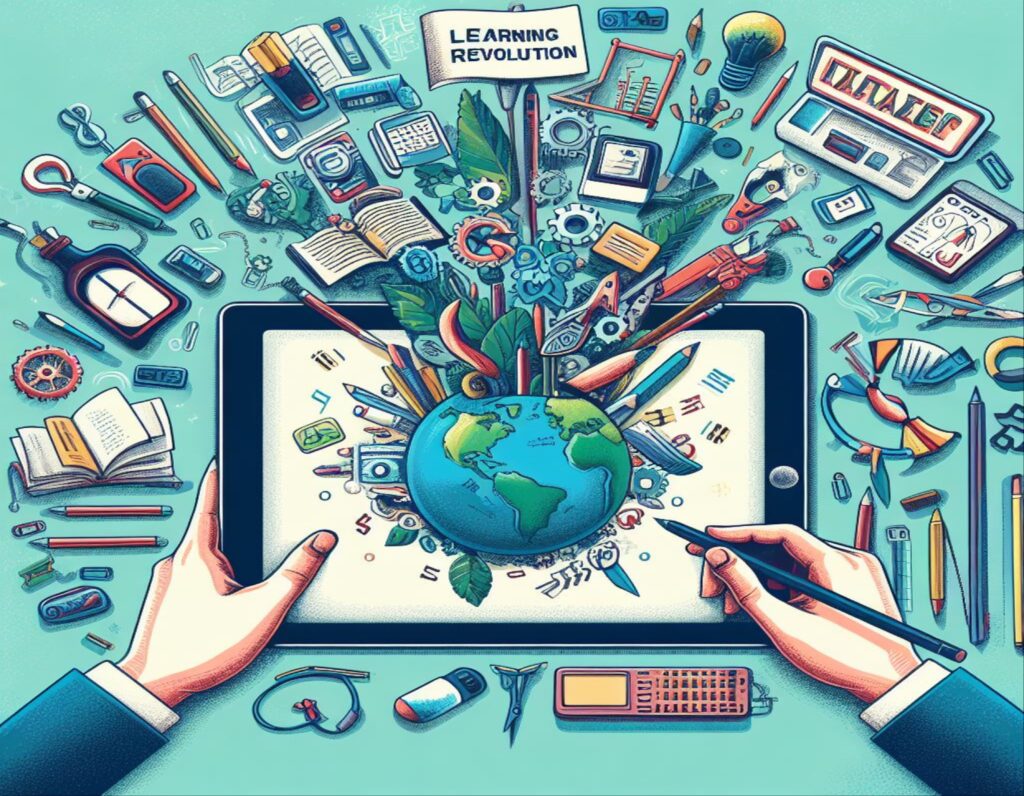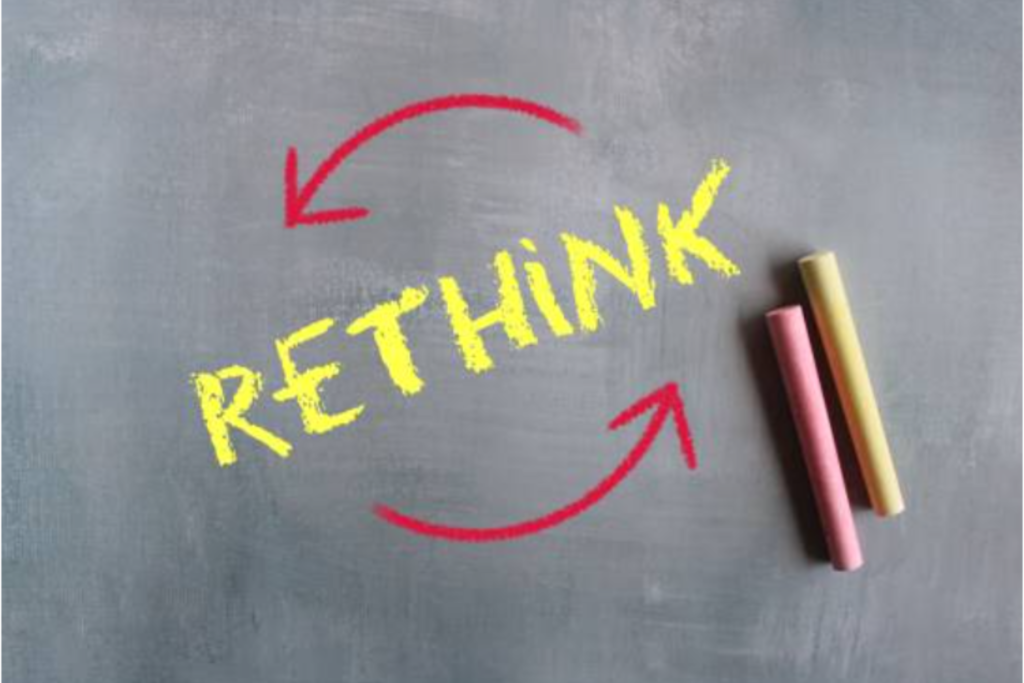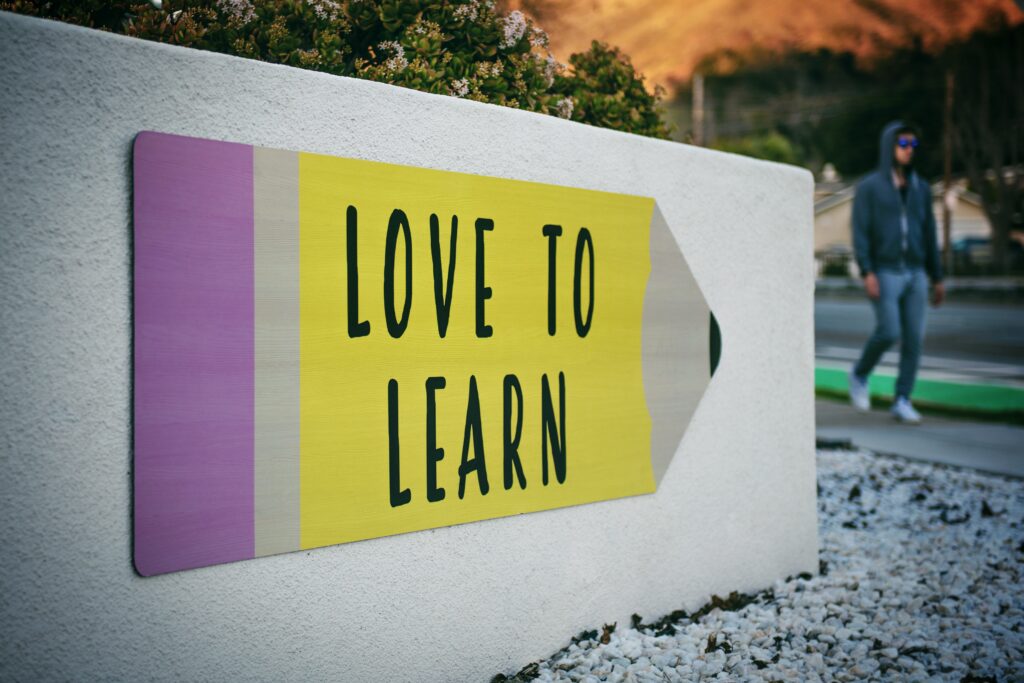
Photo of cover of book. http://www.newcultureoflearning.com
How Creating a Signficant Learning Environment will Impact my Innovation Plan
Incorporating the principles outlined by Thomas and Brown in their book, “A New Culture of Learning“, into my innovation plan, “Interactive Learning Pods: A Dynamic Blended Learning Solution“, can significantly enhance the learning experience and address several key challenges in education. Let’s break down how a shift to creating significant learning environments can impact my innovation plan:
Participation and Collaboration
In the book “A New Culture of Learning“, Thomas and Brown stress the vital role of participation and collaboration in the process of education. This idea is beautifully captured in the quote, “people learn through their interaction and participation in fluid relationships that are the result of shared interest and opportunity” (Thomas and Brown, 2011, p. 50). In essence, learning becomes a dynamic, collective effort driven by shared interests and the opportunities to interact and engage with one another.
In the context of my station rotation blended learning approach, these principles find real-world application. This method is designed to cultivate active involvement and collaboration among students, particularly within small groups. By working together, students have the chance to combine their knowledge, engage in meaningful discussions, and learn from their peers. This cooperative atmosphere not only enriches the learning experience but also reflects the participatory and collaborative principles advocated by “A New Culture of Learning“.
This approach is not just about acquiring knowledge but also about learning how to communicate, share, and co-create knowledge. In the process, students develop crucial skills in teamwork, communication, and problem-solving, which are essential in today’s world where collaborative work and shared learning experiences are increasingly valuable. Furthermore, this method creates a supportive environment that nurtures a sense of community and shared responsibility, contributing to a more engaging and effective learning process.
Imagination and Creativity
The book underscores the vital role of imagination and creativity in the learning process, and these principles can be powerfully integrated into my innovation plan through a variety of activities within the learning small groups. These activities are not only engaging but also effective in promoting creative thinking, the exploration of new ideas, and collaborative problem-solving in elementary math classes.
- Math Puzzles and Riddles: Incorporate math puzzles and riddles that require students to think creatively and critically. For example, present them with challenging word problems that demand innovative solutions. This encourages students to explore different approaches to arrive at solutions collectively.
- Hands-On Projects: Engage students in hands-on projects that involve real-world math applications. For instance, they could work on designing and building geometric shapes, measuring and constructing models, or even creating their math-related board games. These projects foster creativity and problem-solving skills.
- Math Storytelling: Encourage students to create math-related stories or scenarios. They can write and share stories that involve mathematical concepts or explain mathematical ideas through narratives. This approach combines imagination with learning, making math more relatable and enjoyable.
- Collaborative Problem-Solving: Pose complex math problems that require students to work together to find solutions. For instance, I can present them with a challenging mathematical puzzle or a problem-solving scenario. Encourage students to brainstorm, discuss, and experiment with different strategies to reach solutions collectively.
- Math Games and Challenges: Implement math games that encourage friendly competition and problem-solving. Activities like math bingo, math jeopardy, or mathematical board games can spark enthusiasm for math and stimulate creative thinking as students strategize and compete.
- Real-World Math Investigations: Task students with real-world math investigations. For instance, they can explore concepts like measurement by conducting surveys and analyzing data. This approach allows students to apply their mathematical knowledge to solve practical problems, fostering creativity and problem-solving skills.
By incorporating these activities into the small learning groups, my innovation plan aligns perfectly with the idea that imagination and creativity are essential tools for adapting to change. Students are encouraged to approach mathematical challenges with innovative thinking and collaborative problem-solving, preparing them not only to excel in math but also to thrive in a world of constant change.
Play and Experimentation
In the book “A New Culture of Learning“, Douglas Thomas and John Seely Brown underscore the value of play and experimentation in the learning process. Certainly, the concept of allowing students to experiment, make adjustments, and learn through trial and error is incredibly valuable, especially within the context of elementary math classes. By including this approach into my innovation plan, students can not only grasp mathematical concepts more effectively but also develop problem-solving skills and a deeper understanding of the subject matter. These principles can be effectively incorporated into my innovation plan by implementing a range of activities within the small learning groups.
- Math Game Development: Encourage students to create their math games. They can design board games, card games, or even digital games that involve math problems and puzzles. As they playtest their creations, they’ll need to make adjustments to ensure the games are engaging and educational. This hands-on experience not only reinforces mathematical concepts but also encourages creative thinking.
- Fraction Pizza: In a lesson on fractions, have students design their “fraction pizzas.” They can cut out circular pieces of paper to represent pizzas and then divide them into fractions. Students can experiment with different fractions to understand the concept better. For instance, they can cut a pizza into halves, thirds, or quarters, and explore the relationship between them.
- Geometry Scavenger Hunt: Organize a geometry scavenger hunt where students search for geometric shapes in their surroundings. They can take pictures of objects with various shapes, such as triangles, rectangles, and circles. Upon returning to the classroom, students can classify and analyze the shapes they found, offering an opportunity to experiment with geometry in the real world.
- Measurement Olympics: Host a “Measurement Olympics” event where students engage in measurement-related challenges. For instance, they can measure the distance of long jumps, the weight of various objects, or the volume of liquid in containers. By making measurements, making adjustments, and comparing results, they’ll grasp the concept of measurement and understand the importance of precision.
- Mystery Math Challenges: Present students with math mysteries or riddles that require them to experiment with different approaches to find solutions. For instance, they can solve logic puzzles, decipher mathematical codes, or explore patterns. This approach encourages students to think critically, make adjustments, and develop a deeper understanding of math.
- Math Experiments: Introduce simple math experiments that students can conduct in the classroom. For example, they can explore probability by rolling dice or flipping coins. By recording and analyzing their results, students learn to make predictions and adjust their strategies based on data.
- Building with Shapes: Provide students with various geometric shapes like building blocks and encourage them to construct three-dimensional structures. They can experiment with different arrangements to understand spatial concepts, volume, and geometry.
By integrating these activities into the small learning groups, students have the opportunity to actively engage with math concepts, learn through experimentation, and develop a profound understanding of the subject matter. This approach aligns perfectly with the principles of “play” and experimentation advocated in “A New Culture of Learning,” preparing students for a future where adaptability and creative problem-solving are essential skills.
Technology Integration
Certainly, as I delve into enhancing the learning experience for elementary students in math classes, I recognize the significant role of technology in today’s educational landscape. Building on the insights from ” A New Culture of Learning” by Douglas Thomas and John Seely Brown, I’m excited to incorporate technology-driven activities that align with my innovation plan.
To create a dynamic learning environment, I’ll integrate a variety of technology-driven activities into my math classes at the elementary school level. Here are specific examples of these activities:
- Online Math Games and Apps: I’ll introduce students to a range of math games and applications designed for elementary learners. Platforms like Prodigy, Coolmath Games, and Khan Academy Kids will be valuable resources. These engaging tools enable students to solve math problems, play interactive games, and even compete with their peers, making math both enjoyable and educational.
- Virtual Math Manipulatives: To enhance the understanding of abstract mathematical concepts, I’ll use digital manipulatives. These tools simulate physical math aids used in classrooms, such as base-ten blocks, fraction tiles, and number lines. They allow students to experiment with math concepts, providing a tangible learning experience.
- Digital Math Journals: I’ll encourage my students to keep digital math journals or blogs. In these journals, they can document their math problem-solving processes, discoveries, and reflections. This activity not only enhances their digital literacy but also fosters self-expression and a deeper grasp of mathematical ideas.
- Online Math Challenges: To challenge my students and encourage critical thinking, I’ll involve them in online math competitions. Platforms like Math Olympiad, Math Kangaroo, and the American Mathematics Competitions provide a wealth of math problems and puzzles. These challenges inspire problem-solving skills and mathematical creativity.
- Digital Storytelling with Math: Using digital storytelling tools, I’ll guide students in creating narratives that involve mathematical problem-solving. They can incorporate multimedia elements like images, videos, and audio to explain their thought processes and solutions. This approach enhances both their communication skills and mathematical understanding.
- Math Data Analysis: I’ll introduce students to data analysis using digital spreadsheets. They can collect data on topics of interest, create graphs and charts, and draw conclusions based on the information. This activity not only enhances their math skills but also equips them with valuable data literacy.
- Online Math Challenges and Puzzles: Platforms like the National Council of Teachers of Mathematics (NCTM) Illuminations and Math Playground will be part of my toolkit. These platforms offer a variety of math challenges and puzzles to encourage critical thinking and problem-solving while making learning enjoyable.
Main Challenges and How I will Address Them
Now that we understand the problems that the creation of significant learning environments will address and its potential impact on my innovation plan, let’s explore the core challenges and how I plan to address them.
Finding the Right Technology Resources
One challenge I’ll face is finding the right technology resources. This entails identifying and selecting the most suitable technology resources from those already available at our school. It’s a time-consuming process that requires extensive research, testing, and ensuring compatibility with the learning objectives and goals of my innovation proposal. To address this challenge, I can start by conducting a comprehensive inventory of the existing technology resources at our school. I should consider their features, capabilities, and how they align with my goals and learning objectives. For instance, if I’m in search of an interactive learning platform, I might need to assess various options, such as learning management systems, software applications, or online tools. Testing a few options is advisable to determine which one best suits my approach. Additionally, I could collaborate with the school’s IT department or seek advice from colleagues who have experience with these resources.
Evolving the Teacher’s Role to a Facilitator
One of the substantial challenges I’ll encounter is the shift in my role from a traditional instructor to a facilitator of learning. This transition demands a change in pedagogical approaches, classroom dynamics, and teacher-student interactions. I plan to initiate a gradual transition by clearly communicating the new role expectations to the students.
To develop the necessary facilitation skills, I’ll need to seek professional development opportunities, workshops, and training sessions. This professional development is designed to enhance my ability to guide students in their learning journeys effectively. I can also reach out to my math coach and other teachers from the same subject to come into my classroom during the time I’m piloting this initiative, so I can get feedback from them for improvements. I’ll explore success stories and examples of effective facilitation to inspire and motivate myself to embrace this role transformation. Providing ongoing self-feedback and self-support will be essential to ensure a smooth evolution of my role as a facilitator.
Customizing Learning Plans for Individual Students
Customizing learning plans for each student within my initiative can be time-consuming, especially if I have a large number of students. This challenge involves tailoring learning plans to address each student’s unique strengths, weaknesses, and learning preferences. While ongoing assessment of student progress is crucial, streamlining the process of customization is equally vital. I plan to create templates or frameworks for personalized learning plans that encompass common learning goals and strategies. These templates will serve as a foundation, allowing me to focus on the specific areas where each student needs individualized attention. Additionally, I’ll consider involving students in the customization process. Encouraging them to reflect on their learning needs and preferences can foster a sense of ownership over their learning plans. This approach can help reduce the time burden on my end while still providing personalized guidance to students.
If you’d like to learn more about my Innovation Plan, you can find additional details by following this link.
References
Thomas, D., & Brown, J. S. (2011). A new culture of learning: Cultivating the imagination for a world of constant change. Lexington, Ky, USA: CreateSpace Independent Publishing Platform.
Harapnuik, D. (2015, May 8). Creating significant learning environments. Retrieved from https://www.youtube.com/watch?v=eZ-c7rz7eT4.
Ted x Talks. (2012, September 12). A new culture of learning: Douglas Thomas at tedxufm. Retrieved from https://youtu.be/lM80GXlyX0U.
NOTE: As an Amazon Associate I earn from qualifying purchases.






